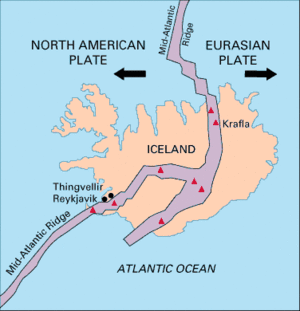Geology of Iceland

The geology of Iceland is unique and of particular interest to geologists. Iceland lies on the divergent boundary between the Eurasian plate and the North American plate. It also lies above a hotspot, the Iceland plume, which is believed to have caused the formation of Iceland itself, the island first appearing over the ocean surface about 16 to 18 million years ago.[1][2][dead link] The result is an island characterised by repeated volcanism and geothermal phenomena such as geysers.
The eruption of Laki in 1783 caused much devastation and loss of life; lead to famine which then killed approximately 25% of the island's human population,[3] caused a drop in global temperatures, as sulfur dioxide was spewed into the Northern Hemisphere. This caused crop failures in Europe and may have caused droughts in India. The eruption has been estimated to have killed over six million people globally,[4] making it the deadliest in historical times.[citation needed]
In the period 1965 to 1969 the new island of Surtsey was created on the southwest coast by a volcanic eruption.
Chronology
Opening of the North Atlantic
- Iceland plume
- Iceland hotspot
- Rifting of the north Atlantic
Cenozoic fossiliferous strata
- Vegetational changes
- Past climate
- Origin of the strata
- Fossil preservation
Glaciations
- Glacier extent
- Nunataks and icefree areas
- Interglacials
- Tuyas and subcanism
Holocene changes and volcanism
- Revegetation
- Increased volcanism
- Soil formation
- Isostatic rebound
- Holocene sediments
- Coastal erosion
Human impact and natural catastrophes
Current climate change
- General glacier retreat
- Tree line rise
- Sea level rise
Current tectonics
- Rift jump
- Seismic activity
- Volcano tectonics
See also
References
- ^ Tobias Weisenberger (2013). "Introduction to the geology of Iceland".
- ^ "Catalogue of the Active Volcanoes of the World, Vol. 24" (PDF). Retrieved 2012-08-01.
- ^ Gunnar Karlsson (2000), Iceland's 1100 Years, p. 181
- ^ How The Earth Was Made: The Age of Earth (video), History.com
External links
- Maps and illustrative photos from Union College
- Trønnes, R.G. 2002: Field trip: Introduction. Geology and geodynamics of Iceland. In: S. Planke (ed.) Iceland 2002 – Petroloeum Geology Field Trip Guide, prepared for Statoil Faroes Licence Groups by Volcanic Basin Petroleum Research, Nordic Volcanological Institute and Iceland National Energy Authority, p. 23-43.
- Thor Thordarson. Outline of Geology of Iceland. Chapman Conference 2012


